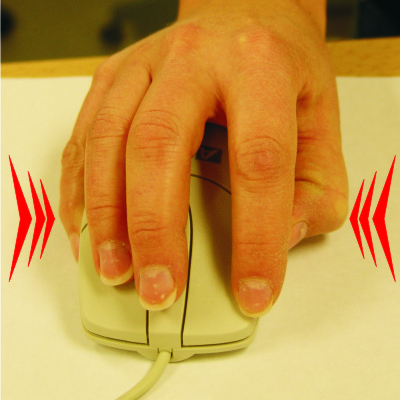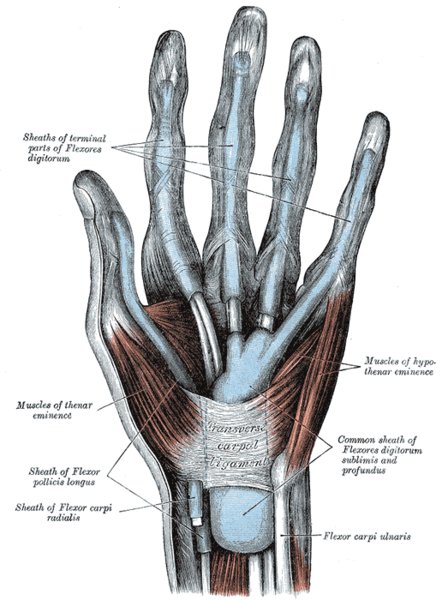 Static
Grip Force When Using the Mouse
Static
Grip Force When Using the Mouse
What
is Static Grip Force?
Static Grip Force is the effort arising from maintaining an
ongoing "pinch" or constant grip to hold and move the
mouse. It is largely a consequence of the symmetrical
design of most mice, accompanied by the lack of either sculpting
or sizing. Some mice such as
Orthopedic
Mice are not only asymmetric but also anatomically derived
and support the bone structures and muscle systems of the hand.
However, because most conventional mice have a flawed design
that fails to take into consideration the anatomy of the hand,
individuals are forced to maintain a steady pinch grip force on
both sides of the mouse in order to accurately control the mouse
and achieve precise cursor movement. This is typically applied
with the thumb and fifth finger as shown in the image at right.
Individuals often exert this effort even when not actively
targeting or using the mouse, resulting in far more strain and
fatigue than one would otherwise expect to arise from what
should be an intermittent concerted effort task. Due to the task
driven nature of working at a computer, very few individuals
relax the grip on the mouse or take their hand off the mouse
when they complete a point and click action, likely because they
want to avoid a delay before the next mousing action which could
occur at any time.
Why is Static Grip Force a Risk Factor?
When an individual constantly engages the muscles in their hand,
this places a
Static
Load and strain on the joints, muscles and membranes in
the hand, wrist and arm. This constant burden can lead to
fatigue, discomfort, pain and injury.
In extreme cases this can lead to a "Death Grip" on the
mouse—this is where the static grip behaviour has become so
entrenched that the user is now maintaining an excessive grip on
the mouse at all times, purely out of habit. This will also
often lead to involuntary gripping, pinching or curling of the
fingers, even when not using a mouse or pointing device. As
Static Grip Force arising from significant mousing is a prime
risk factor for anyone who uses a traditional mouse, prevention
of this behaviour should be a key consideration.
How Much Static Grip Force (or Pinch Force) is "OK" and not a
Risk Factor?
Everyone has different level of strength, dexterity, endurance
and fatigue rate in the muscles in their hands. For most,
anything other than a minimal amount of pinch or grip force can
cause fatigue and pain in the muscles if the action is
continually performed over an extended period of time (e.g.
gripping the mouse even while not actively using the mouse
through the workday). If an individual uses their mouse for only
brief periods without intensity, this temporary non-neutral
posture and muscle exertion may not cause any long-term hand
condition. However, as noted earlier, the failure to relax the
grip or remove the hand from the mouse significantly extends the
period. Anyone who intensively uses the mouse for even an hour a
day or regularly performs mousing activities throughout the day
is at risk of injuring themselves over a period of time.
 What are
the Symptoms of Too Much Static Grip Force?
What are
the Symptoms of Too Much Static Grip Force?
When the muscles of the hand are called upon to maintain a
Static Grip Force for an extended period, the
flexor
muscles of the hand (those used to close the hand
into a fist) will be overused, creating a strength imbalance
relative to the
extensor muscles which are used
to open the hand. Typically the pain will be throughout the hand
and wrist and radiate up the forearm. The localized pain
is most commonly in the underside of the hand under the thumb (
thenar
eminence), the top or back of the hand (
transverse
carpal ligament), the underside of the forearm
either at the wrist (
flexor retinaculum) or about
2-4" up from the wrist (
flexor carpi radialis).
Typically the pain presents itself as a constant burning pain,
without any pulses or variance.
What is "Death Grip"?
A subsequent more serious condition which can arise from
Static Grip Force is "Death Grip". This refers to when, even
during periods of inactivity, a viselike grip is maintained on
the mouse to the point where the hand never gets a chance to
rest. Exacerbating this is a common bad habit of many, who in
order to increase the feeling of control while working, grip the
mouse harder than is actually required. This becomes such an
ingrained effort that it seems that not even death would abate
the gripping action, thus the term "Death Grip".
What is surprising is that gripping a mouse with more force than
is required or optimal will actually reduce the amount of
control. This reduction arises because when muscles are held in
tension they must relax and recover before they can work again.
As such, sustained Static Grip Force actually reduces the
ability to control the mouse because the muscles are never
relaxed to the point of recovery. However, when a user feels
that they have less control they will instinctively tighten
their grip further, resulting in a further reduction in control,
with a corresponding increase in Static Grip Force. This cycle
is what develops into the "Death Grip".
How Can the Choice of Mouse Help to Reduce Static Grip Force?
Orthopedic
Mice are sized and sculpted to fit and provide support to
the hand. By employing gravity and specifically contoured
profiles these designs can provide control without the
requirement of grip force. This can reduce or even eliminate the
possibility of static grip force issues being encountered. Other
types of pointing devices such as
Central
Pointing Devices,
Touchpads,
and
Trackballs
remove the source of grip force, through the alternate paradigm
employed for mousing and removing the action (grasping an
object) from the action of mousing.
Fingertip
Mice can replace the traditional pinch force with a lower
force precision grip which is for most individuals not a risk
factor. How are these two actions different? When one holds and
turns a key, that requires pinch force which is static, whereas
when one writes with a pen, that is precision grip and the
application of the force is dynamic.
What Other Strategies Can be Used to Reduce Static Grip
Force?
A simple do-it-yourself solution is to take the hand off the
mouse when not actively mousing, which greatly reduces the
amount of time spent gripping the mouse. This will ensure that
the hand is only grasping a non-ergonomic mouse when actively
mousing. Alternatively, paying attention to the tension in the
hand, and learning to consciously relax the muscles while
maintaining relaxed contact with the mouse will actually result
in greater cursor control. With time this new behaviour could
become habitual.

 Static
Grip Force When Using the Mouse
Static
Grip Force When Using the Mouse What are
the Symptoms of Too Much Static Grip Force?
What are
the Symptoms of Too Much Static Grip Force?